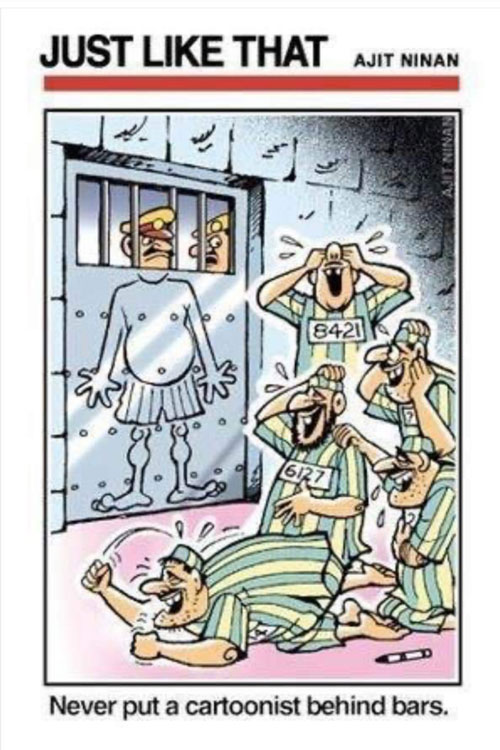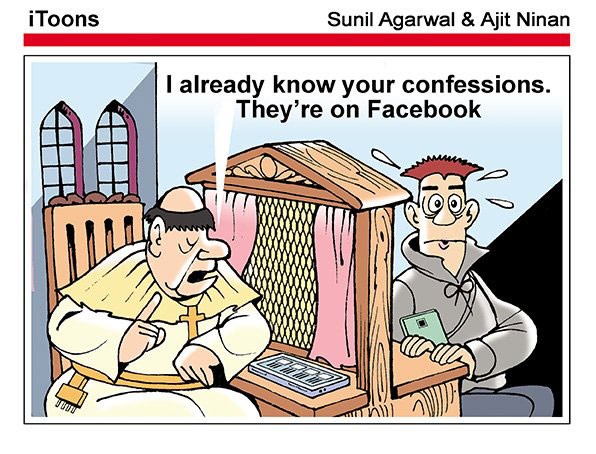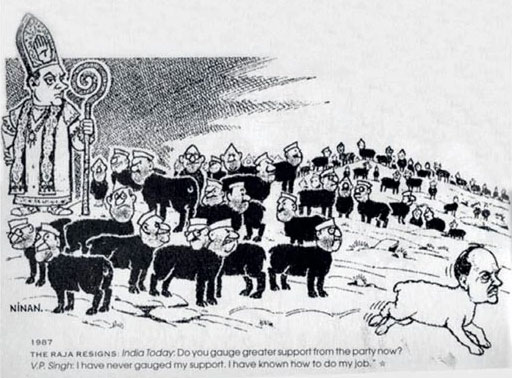Ajit Ninan was an Indian political cartoonist and comic artist. He drew one-panel gag cartoons about current events. For the newspaper Times Of India, he made the daily gag series 'Just Like That!', 'Like That Only', 'Ninan's World' and 'iToons'. His economy-themed gag series 'CEOtoons' ran in Biz-Daily, while his series 'Wit's End' ran in Crest Weekly. For the children's magazine Target, he drew the funny adventure comic series 'Detective Moochhwala' (1979-1991).
Early life and career
Ajit Ninan Mathew was born in 1955 in Hyderabad, a city in the South East coastal province of Andhra Pradesh. His uncle was Abu Abraham, a famous cartoonist. Contrary to many of his fellow citizens, Ninan didn't come from a Hindu or Buddhist background, but from a Syrian Christian family. From a young age, he enjoyed drawing, particularly machines and turbines. In school, he was often suspended for caricaturing the teachers. This gave him the time to sit in the library and read copies of Punch and The New Yorker. Among Ninan's graphic influences were Mario Miranda, James Thurber and Arnold Roth . In 1968 or 1969, while he was still in high school, Ninan's first cartoon ran in the children's magazine Shankar's Weekly, which however closed down shortly afterwards.
Between 1972 and 1977, Ninan studied at Madras Christian College in Tambaram, Chennai, where he obtained B.A. and M.A. degrees in Political Science. He worked at F.D. Stewarts, an ad agency in Chennai, before being transferred to the Indian capital New Delhi, where he would live for the majority of his life. In 2021, he moved to Mysore.
Detective Moochhwala
In 1979, the first issue of the Indian children's magazine Target rolled from the presses. The magazine was owned by Living Media, the same publisher that distributed India Today. Much of its material was copied from Mad Magazine, but they also offered room for local comic creators, like Jayanto & Neelabh Banerjee ('Gardhab Das'), Praloy Chakrovorty, Joygopal Podder ('Granny's Gushup'), Suddhasattwa Basu ('It Happened in History'), Priya Nagarjan ('Science News'), Atanu Roy (the 'Hahaha' joke page), Sujata Singh and Manjula Padmanabhan.
One of Target's most popular features was Ajit Ninan's 'Detective Moochhwala' (1979-1991). Detective stories have always been massively popular in Indian culture and were therefore ripe for parody. Inspired by 'The Pink Panther' film franchise (characters designed by Friz Freleng), the comic stars a big-nosed, mustached detective who solves crimes. His name Moochhwala literally translates to "mustache" in Hindi. Ninan borrowed his distinctive mustache from David Low's character 'Colonel Blimp'. Moochhwala is accompanied by his loyal dog Pooch (sometimes spelled as "Poonch"). In English, the word "pooch" happens to refer to "dog", but in Hindi the word "poonch" also means "tail". Together they have many humorous adventures, where wacky inventions and gadgets often drive the plots and gags forward.
In January 1991, Target rebooted itself and discontinued several of its local series, including 'Detective Moochhwala'. Four years later, the magazine was retitled to Teens Today, but this magazine failed to attract more readers, and quickly disappeared from the market.
Political cartoon, 19 March 1982.
Political cartoons
Through his work in children's magazine Target, Ninan was discovered by Aroon Purie, publisher at the weekly news magazine India Today. He asked him to join their staff as a political cartoonist. His only demands were that Ninan should make detailed illustrations, with a focus on visual comedy instead of puns. His cartoon series 'Centrestage' ran both in the national and the regional editions of India Today. For the newspaper Times of India, Ajit Ninan drew the daily gag series 'Just Like That'. One of his best-known cartoons in this series depicts a group of jail inmates laughing at a drawing of a police officer in underwear, with the tagline: "Never put a cartoonist behind bars." This timeless comment on censorship has often been reprinted and shared online.
'Just Like That': Ajit Ninan's famous 'Never put a cartoonist behind bars' cartoon.
On a bi-weekly basis, Ninan and columnist Jug Suraiya made the collaborative one-panel cartoon series 'Like That Only' for Times of India. Much of their correspondence happened through telegraph. A compilation of gags was published in book form under the title 'Like That Only' (Times Group Books, 2007). Jug Suraiya also scripted another cartoon series for Times of India, 'Duniya ke Neta', drawn by Neelabh Banerjee. Together with scriptwriter Manav Paul and again Banerjee, Jug Suraiya also scripted the shorter-lived political satire comic 'Dubyaman', targeting U.S. President George Bush Jr.
'Ninan's World', also published in Times of India, offered Ajit Ninan's view on present-day affairs. Together with scriptwriter Sunil Agarwal, he made the one-panel cartoon series 'iToons'. Ninan was one of the first Indian newspaper cartoonists to use a computer for the coloring of his drawings and make them readable on smartphones. 'CEOtoons', published in the economics magazine Biz-Daily, poked fun at the world of business. 'Wit's End' ran in Crest Weekly. His cartoons also ran in Outlook and, starting in 1992, Indian Express.
'iToons'.
Ajit Ninan always arrived at the newspaper office early, so he had time to create his cartoons in peace and quiet, before the other journalists started rushing in to cover and discuss the latest news stories. If photographs couldn't be obtained, he made extra cartoons and caricatures for that day's edition. Cartoonist Sandeep Adhwaryu recalled that Ajit Ninan once gave him the following advice: "Try to find humor in everyday life. And if you can't find it, create it."
Ajit Ninan's controversial 1987 cartoon, depicting Rajiv Gandhi (as the Pope) and V.P. Singh (as a white sheep).
Controversy
One 1987 cartoon by Ninan depicting Indian Prime Minister Rajiv Gandhi as the Pope herding black and white sheep caused controversy when it appeared in print. Instead of a Christian cross, Gandhi wore the Congressional hand symbol on his sleeve, while Minister of Defense, V.P. Singh, was depicted as a white sheep running away from the flock. Several Christian readers wrote to complain about this blasphemous cartoon. Another Ninan cartoon offended Hindus: he had drawn the Indian map in the shape of Hindu god Ganesha's head, while his body was drawn in a bloated shape, to symbolise the corruption in the public sector. At Ganesha's feet, a politician worshiped him. Ninan recalled that at least seven Ganesha associations submitted angry readers' letters.
1999 sequential cartoon by Ajit Ninan, depicting Sonia Gandhi.
Recognition
In 1986, Ninan received the Sanskriti Award for Journalism. In 2016, his cartoons were the subject of an exhibition at the Museum of Australian Democracy at Old Parliament House in Canberra, Australia. In 2022, the Indian Institute of Cartoonists honored him with the Barton Lifetime Achievement Award.
Death and legacy
Ajit Ninan died in 2023, at age 68. According to a family member, his death was caused by a cardiac arrest. Ajit Ninan's work was an influence on the cartoonists Sandeep Adhwaryu, Satish Acharya, Neelabh Banerjee, Priya Kuriyan, Bhishwadeep Moitra, Ravi Shankar and Nirmal Sharwa. Indian Congress leader Jairam Ramesh mourned Ninan and stated "he enlivened India Today and Times of India in his inimitable style." He ranked him as part of the same grand tradition as other cartoonists, like Ravi Shankar, and "inspired many whose cartoons we see today that make us smile."










